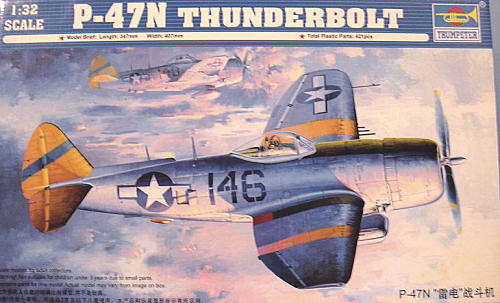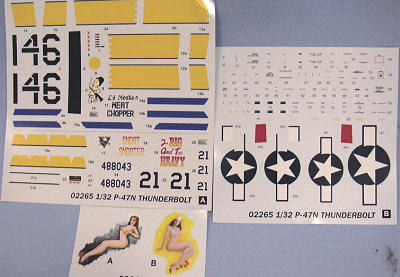|
KIT: |
Trumpeter 1/32 P-47N Thunderbolt |
|
KIT #: |
2265 |
|
PRICE: |
$149.95 MSRP
|
|
DECALS: |
Two options |
|
REVIEWER: |
Tom Cleaver |
|
NOTES: |
|

The P-47 was originally designed as
a high altitude interceptor, in which range would not be a major consideration.
Once in production, it was the only
American fighter that seemed to have much chance against the Luftwaffe, and was
pressed into service as an escort fighter for the day bombing campaign, a role
that sorely taxed the airplane as more and more drop tanks were hung on it in an
effort to give it the range to escort daylight missions over Germany.
Eventually, the P-47 gave way to
the P-51 in this role, and it became the scythe that crossed western Europe
following D-Day, flying tactical air support for the Allied armies, a task at
which it excelled.
However, in 1943, while the P-47
was still in demand as an escort fighter, consideration was given to extending
the range as much as possible, since the coming B-29 campaign against Japan
would need long range escort fighters with even greater range than that of the
P-51.
The result was the P-47N, the final
Thunderbolt to be produced.
In the spring of 1944, four
P-47D-27-RE airframes had been taken off the Farmingdale production line and
fitted with the Pratt & Whitney R-2800-57(C) engine which - driving a larger
CH-5 turbosupercharger -
could produce a war emergency power
of 2800 hp at 32,500 feet with water injection. These aircraft became the
prototypes for the P-47M series.
That summer, the third YP-47M
prototype was fitted with a new "wet" wing of greater span and area. For the
first time in the Thunderbolt series, a 93 US gallon tank was fitted in each
wing. When maximum external tankage was carried, total fuel load of the XP-47N
was an impressive 1266 US gallons, making possible a range of 2350 miles.
Additionally, the new wing incorporated larger ailerons and squared-off
wingtips, which enhanced the roll-rate and improved maneuverability. The dorsal
fin was larger than that on the P-47D. In order to cope with the increased gross
weight from the increased fuel load, the undercarriage had to be strengthened,
which increased weight still further. The maximum weight rose to over 20,000
pounds, making the P-47N the biggest, heaviest piston-engine single seat fighter
to ever see service.
The
XP-47N flew for the first time on July 22, 1944.
Following a production contract for
1,900 P-47Ns that had been ordered on June 20, 1944. The first P-47N-1-RE
appeared in September, 1944, with 24 delivered by year's end. The P-47N-5-RE and
subsequent batches had zero-length rocket launchers added.
Several P-47N Groups gave excellent
service in the Pacific, following the invasion of Okinawa, when three groups
took up residence on Ie Shima island and provided escort to Fifth Air Force
B-24s on missions over Kyushu, as well as for B-29 missions over southern Japan.
One P-47N group, the 414th
Fighter Group, became operational on Iwo Jima before the end of the war but did
not fly any missions over the home islands before the war was over.
1,667 P-47Ns were produced at
Farmingdale between December 1944 and December 1945, when the line finally
closed. 149 other P-47Ns were built at Evansville factory. At the end of
production, cost of a Thunderbolt was $83,000 in 1945 U.S. dollars (about $8
million in today’s dollars).
The P-47N soldiered on into the
mid-1950s with several units of the Air National Guard.
It has always been a mystery why
these airplanes, which were far better suited for the ground attack mission than
was the P-51D Mustang, were not activated and sent to Korea.
Several hundred Mustang pilots who
were killed might have survived the war had this been done.
(A frequently asked question, to be sure.
From what I've been able to determine, it was that there were parts and overhaul
facilities for Mustang airframe and engines already in place in the Far
East when the war broke out. The FEAF had several squadrons of Mustangs already
in theater that could be used immediately as well. Bringing in the mass of parts
and setting up Thunderbolt servicing centers would have not only delayed
overhaul of the P-47s needing it, it would have meant that other war materiel
would have been delayed to make room on ships for the Thunderbolt stuff. Add to
this that there were thousands of Mustangs still in US service in the States for
attrition replacement. It was as much expediency as anything else that prevented
the P-47 from seeing Korean service. Ed)
Performance of the P-47N-5-RE
included a maximum speed of 397 mph at 10,000 feet, 448 mph at 25,000 feet, and
460 mph at 30,000 feet. Initial climb rate was 2,770 feet per minute at 5000
feet and 2,550 feet per minute at 20,000 feet. Range fully fueled was 2,350
miles.
 There have been two different P-47N
kits released in 1/48 scale, one by Academy and one by Pro-Modeler.
While the Academy kit is easier to
build, the Pro-Modeler kit is the more accurate.
There have been two different P-47N
kits released in 1/48 scale, one by Academy and one by Pro-Modeler.
While the Academy kit is easier to
build, the Pro-Modeler kit is the more accurate.
This P-47N by Trumpeter is the first of t his
version of the Thunderbolt in 1/32 scale.
his
version of the Thunderbolt in 1/32 scale.
The kit differs from the previous
P-47D bubbletop kit in having a different fin and rudder, different wings and a
two-piece bubble canopy.
Unfortunately, it maintains the
corrugated cockpit floor of the P-47D-25.
 Otherwise, it
is the same highly-detailed kit as the P-47D razorback and bubbletop kits
released over the past year.
Full detail is provided for the
R-2800-57(C) engine.
Otherwise, it
is the same highly-detailed kit as the P-47D razorback and bubbletop kits
released over the past year.
Full detail is provided for the
R-2800-57(C) engine.
Decals are provided for two
aircraft.
Unfortunately, like most Trumpeter
decals, they are not particularly accurate, though the nekkid wimmen for “Short
Snorter/2 Big and 2 Heavy” are good.
This makes up into a detailed,
accurate kit, with lots of parts left over for the modeler who doesn’t choose to
open up the lower fuselage to display the turbo-supercharging ducting, or the
gun bays.
Yes, the kit still has rivets, but
they are not any more intrusive than those on the Me-262s (either that or I have
lived “downwind of the feedlot” long enough to have lost my sense of smell on
this issue). The detailing provided does give the super-detailer lots of
material to work with.
Highly recommended.
Thanks to Stevens International for the review kit.
Tom Cleaver
May 2008
If you would like your product reviewed fairly and quickly, please
contact
me or see other details in the
Note to
Contributors.
Back to the Main Page
Back to the Previews Index Page


 There have been two different P-47N
kits released in 1/48 scale, one by Academy and one by Pro-Modeler.
While the Academy kit is easier to
build, the Pro-Modeler kit is the more accurate.
There have been two different P-47N
kits released in 1/48 scale, one by Academy and one by Pro-Modeler.
While the Academy kit is easier to
build, the Pro-Modeler kit is the more accurate.![]() his
version of the Thunderbolt in 1/32 scale.
his
version of the Thunderbolt in 1/32 scale. Otherwise, it
is the same highly-detailed kit as the P-47D razorback and bubbletop kits
released over the past year.
Full detail is provided for the
R-2800-57(C) engine.
Otherwise, it
is the same highly-detailed kit as the P-47D razorback and bubbletop kits
released over the past year.
Full detail is provided for the
R-2800-57(C) engine.